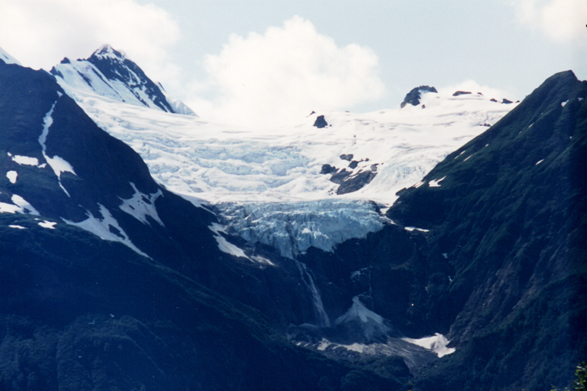Updated 4-26-2002
Written and created by Theresa and Jason B.
Reload or Refresh for Newest Page
Glaciers are moving rivers of
ice. In Alaska glaciers cover 29, 000 sq. miles or 5 % of the state.
There are an estimated 100,000 glaciers in Alaska, ranging from tiny cirque
glaciers to huge valley glaciers.
Glaciers are formed over a number
of years where more snow falls than melts. Alaska Glaciers fall roughly
into five general categories: Alpine, Valley, Piedmont, Ice Fields,
and Ice Caps.
-
Alpine Glaciers
(mountain
and cirque) head high on the slopes of mountains and plateaus.
-
Valley Glaciers
are an overflowing accumulation of ice from mountain or plateau basins.
-
Piedmont
Glaciers result
when one or more glaciers join to form a fan shaped ice mass at the foot
of a mountain range.
-
Ice Fields
develop
when large valley glaciers interconnect, leaving only the highest peaks
and ridges to rise above the ice surface.
-
Ice Caps
are smaller glaciers perched on plateaus.
Glacier ice often appears blue to
the eye, because it absorbs all the colors of the spectrum except blue,
which is scattered back. About three fourths of all the fresh water
in Alaska is stored as glacier ice. This is many times greater than
the volume stored in all the state's lakes, ponds, rivers, and reservoirs.
Glacier
Trivia with Links
-
The longest tidewater glacier in
North America is Hubbard, 76 miles in length
(heads in Canada).
-
The longest glacier is the Bering
(including Bagley Ice Field), more than 100
miles in length.
-
The largest glacier is the Bering
complex, about 2,250 sq. miles in size, which
includes Bagley Ice Field.
-
The Malaspina
Glacier in Alaska is the world's largest piedmont glacier,
covering over 8,000 square kilometers and measuring over 193 kilometers
across at its widest point.
-
North America's longest glacier
is the Bering Glacier in Alaska, measuring
204 kilometers long.
-
Presently, 10% of land area in the
world is covered with glaciers.
-
Glaciers store about 75% of the
world's freshwater.
World
Glaciology Links
-
The
American Geographical Society Collection of historical photos includes
thousands of
photos, primarily of Alaskan glaciers, but also of
glaciers in the Pacific Northwest (U. S. and Canada) and Europe.
-
Glaciology
-
University of British of Columbia, Canada
 |
A Hanging Glacier in Haines,
Alaska 1990
©ETMJ's Alaska 2001
|
Glacial ice often appears blue because ice absorbs
all other colors and reflects blue.
On cloudy days the glaciers look more blue.
|
ICE
WORMS ARE REAL
|
| Although often regarded as a
hoax, ice worms actually exist. These small, thread like, segmented
black worms, usually less than one inch long, thrive in temperatures just
above freezing. Observers as far back as the 1880s reported that
at dawn or dusk or on overcast days, the tiny worms, all belonging to the
genus
Mesenchytraeus, may literally carpet the surface of glaciers.
When sunlight strikes them, they burrow back down into the ice; Temperatures
over 75 degrees can kill the ice worm. |
Please leave your comments about this page
in our Alaska Book on our home page.
©ETMJ's Alaska 2001
To further your quest for knowledge, try this search engine.



